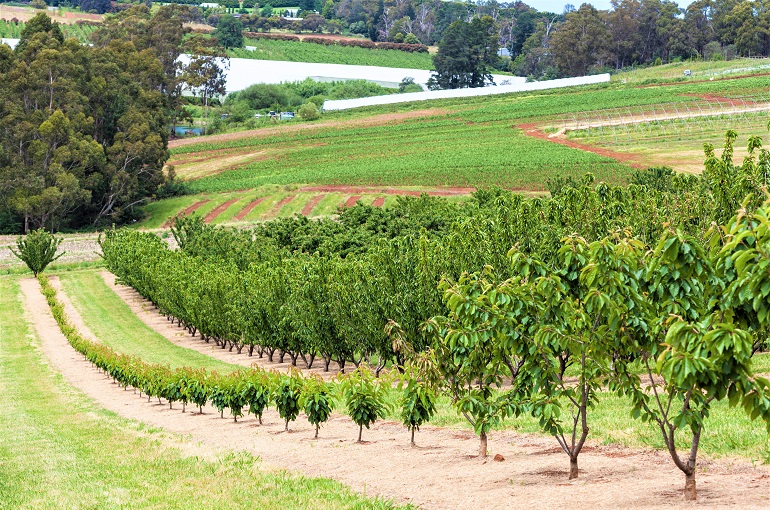Soil requirements, preparation, and planting of cherry trees

This post is also available in:
This post is also available in:
![]() Español (Spanish)
Español (Spanish) ![]() Français (French)
Français (French) ![]() Deutsch (German)
Deutsch (German) ![]() Nederlands (Dutch)
Nederlands (Dutch) ![]() हिन्दी (Hindi)
हिन्दी (Hindi) ![]() العربية (Arabic)
العربية (Arabic) ![]() Türkçe (Turkish)
Türkçe (Turkish) ![]() 简体中文 (Chinese (Simplified))
简体中文 (Chinese (Simplified)) ![]() Ελληνικά (Greek)
Ελληνικά (Greek) ![]() Português (Portuguese (Brazil))
Português (Portuguese (Brazil))
Cherry Tree Soil Requirements and Preparation
Cherry trees thrive both in valleys and higher altitudes (mountainous regions) up to 2500 m. A suitable field for establishing a cherry orchard should not be prone to frost or face to the north but be protected from strong and cold winds. Areas with high humidity and rainfalls during the cherry flowering period (early-mid spring) should be avoided since these conditions can favor the outbreak of diseases. Like all fruit trees, the cherry tree prefers well-drained fertile loam soils with sufficient moisture. However, water-logged and excessively sandy or heavy, calcareous soils should be avoided since cherries are susceptible to root rot. As a rule of thumb, cherry trees prefer soil with a pH ranging from 6 to 7. They also need to be in a sunny location (6-8 hours of direct sun exposure) with good aeration. Even though the cherry tree is resistant to drought and can survive for many years in dry soils, its production is considerably reduced under such conditions. Low soil moisture at the end of the growing season usually is less critical than in the beginning. Therefore, keeping the soil constantly moist is crucial, especially in the first years. Most cherry growers choose to irrigate in areas where the rainfalls are insufficient. Mulching may also be applied to protect the soil moisture (ask your local licensed agronomist).
Growers should perform soil analysis and proper soil preparation before planting. To prepare the soil, cherry growers plow the soil at a depth of 30-40 cm (12-16 inches). This aims at destroying perennial weeds and loosening up the soil in order to facilitate the root establishment and growth of the young cherry trees. In some cases, growers may apply well-rotted manure (0.2-0.3 tonnes per hectare or 0.08-0.12 tonnes per acre) before planting. This will improve soil texture and increase its fertility.
Planting and Spacing of Cherry trees
Planting of young cherry trees usually takes place in late winter to early spring (February to March) or in late autumn (October to December), when the trees are still dormant, and it is best to wait and plant after the last spring frost. Keep in mind that there are significant differences in vigor and production load among the different cherry varieties (rootstocks). This may affect the training of the young plants, and both will affect the planting distances of the trees. Generally, the planting densities range from 500 to over 6,000 trees per hectare (200-2.400 trees per acre). To achieve high-density cherry orchards, the growers apply a spindle, the intensive V-system, or the SSA training systems. Depending on the rootstock type and the training scheme that will be applied, the planting distances may vary from 3 to 12 m (10 to 39 feet) between the rows and 1-10 m (3.2-32 feet) between the trees. However, some typical distances are 5*5 m (16.4*16.4 feet). Another common spacing pattern in a low-density cherry orchard is a 4.5 (14,7 feet) distance between the rows and 5.2 m (17 feet) within the row. Sour cherries can be planted at closer distances compared to sweet cherries, while dwarf varieties can be planted even closer, 2.4-3 m apart (8 to 10 feet).
After purchasing the young grafted cherry trees from the main and the pollinator variety, the grower digs the planting holes (45*45 cm or 17.7*17.7 in), usually twice as wide as the size of the bare root system. The holes should not be too deep, and the graft union should always remain above the soil line. When placing the tree in the hole, you are advised to spread the roots out in all directions and cover them with soil. After planting, it is best to irrigate.
Remember that some cherry varieties are self-sterile and can’t pollinate themselves. Therefore, commercial cherry growers usually plant one row of trees of the pollinating variety for every three rows of the main variety. If the pollinator variety can also be commercially exploited, it can be planted in greater numbers within the orchard. Be careful to select compatible varieties for successful cross-pollination and, thus, fruit production.
References
- https://extension.oregonstate.edu/gardening/berries-fruit/planting-caring-fruit-tree
- https://journals.ashs.org/hortsci/view/journals/hortsci/50/1/article-p59.xml
- https://www.cloudmountainfarmcenter.org/education/grow-tips/growing-cherries/
- https://u.osu.edu/cfaescapstone/tree-fruits/cherries/care-maintenance/
- https://catalog.extension.oregonstate.edu/sites/catalog/files/project/pdf/pnw642.pdf
Cherries: Info, Facts, Nutritional Value & Health Benefits
Plant Information of cherries
10 Interesting Things About Cherries You Probably Didn’t Know
Growing Cherry Trees for Profit
Soil requirements, preparation, and planting of cherry trees
Cherry Tree Water Requirements
Cherry Tree Propagation and Pollination
Cherry Tree Training, Pruning, and Fruit Thinning
Cherry Tree Fertilization
Cherry Tree Pests and Diseases
Cherries Harvesting and Yield per Hectare – Do you pick cherries with the stem on or off?








































































